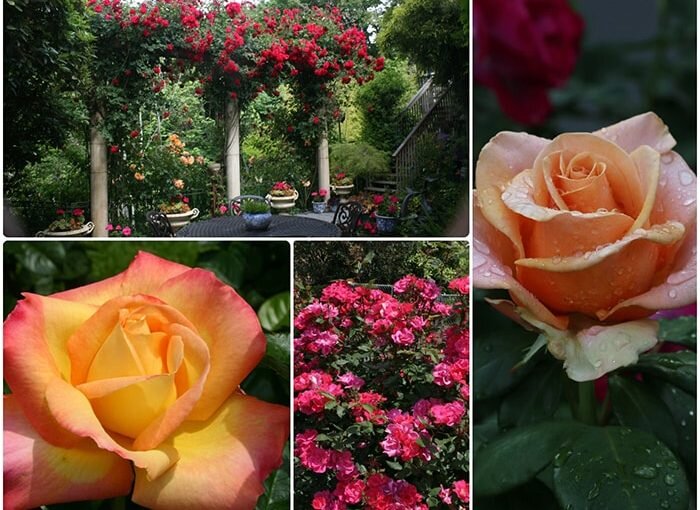During the recent Portland Rose Festival, I attended an event at the International Rose Test Gardens in Washington Park. Just looking out over this wonderful garden with almost 10,000 rose bushes and nearly every one of them in bloom, I reflected on how much roses are intertwined with our city, our lives and our gardens. Portland is, of course, known as The City of Roses and the rose is also our national flower.
The rose bush has long been a fixture in many gardens across the United States and traditionally they were usually planted in a bed designated as 'the rose bed'. Today, gardeners still have 'rose beds' but many gardeners combine rose bushes in a mixed flower bed along with other shrubs and perennials.
It is hard to think of a plant that will provide more continuous bloom than a modern rose bush. In our climate, they will usually begin blooming in May with peak bloom in June. Many roses will then continue blooming throughout the summer, with another peak bloom in the fall.
Our climate is ideal for growing roses and given the right conditions, they should perform well. Most roses need at least six hours of sun as with too much shade the plant will probably be stretching for sunlight and the flowers will be sparse. While roses have had a reputation for being disease prone and requiring a continuous spray program to keep them healthy, many of the new introductions are being bred for disease resistance. Roses do need to be fertilized on a regular basis during the growing season, now is a good time to apply fertilizer especially if your roses have not been fertilized this year.
There are many different kinds of rose bushes so do some checking to be certain that you are getting the type of rose you want.

The 'Ramblin Red' climbing rose in the photo shows not only how spectacular a climbing rose can be but also how vigorous! This rose would certainly not be for a small garden!A hybrid tea rose bush has the traditional long stem rose used for cutting.
Albany, Oregon, John Sitton, won the Queen of the Show award at the Portland Rose Society Spring Show earlier this month with his hybrid tea 'Marilyn Monroe'.There are hundreds of hybrid teas to chose from and the color range is vast.
One of my favorites is 'Love and Peace' which has been almost completely disease-free in my garden.A floribunda rose is generally lower growing and bushier than a hybrid tea and the flowers tend to be in sprays or clusters. They are good plants for a border and also very effective when planted in groups. Shrub roses are as the name indicates, they are a shrub. They are often used in mass landscape plantings such as in parking strips and along freeways.
'Knock Out' is a red shrub that is widely planted in both home gardens and mass public plantings and is very disease resistant as well as an excellent bloomer.If you have put off planting roses because of high maintenance issues, think again. Check the tags of some of the new varieties for disease resistance. You may be pleasantly surprised at how easy they are to grow and their long season of bloom.

We would love to see your roses blooming, use #mywilcolife on Facebook, Twitter, or Instagram and tag Wilco Stores.
MIKE’S GARDEN IS LOCATED IN OREGON’S WILLAMETTE VALLEY AND HIS ADVICE IS CONSISTENT WITH THE MILD CLIMATE THERE.
Orders
Services
About
Your Wilco Store
Store Hours
Monday to Saturday:
8 a.m. to 8 p.m.
Sunday: 9 a.m. to 6 p.m.
Need Help?
For questions or help with online orders call: (888) 78-WILCO
Limited to stock on hand. Some items may vary from photos. Because of store size limitations or geography, some items featured may not be available in all stores but will be made available by special order during sale periods at advertised prices. All sale prices listed as “dollars off” or “% off” are discounted from our regular posted shelf price, not from discounts given with specialty, bulk or pallet pricing. Reseller and Drop-shippers must contact us for pre-approval to place orders with the intent to re-distribute.
© 2025, Wilco Farm Store
